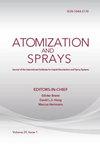基于敏感性分析和主动子空间构建的 RP-3 喷射特性研究
IF 0.9
4区 工程技术
Q4 ENGINEERING, CHEMICAL
引用次数: 0
摘要
为了探索航空燃料 RP-3 的缸内喷射及其后续喷雾动力学,本研究通过扩散器背照式成像(DBI)实验方法,研究了不同喷嘴直径的单孔喷油器在不同环境压力和喷射压力下的 RP-3 喷雾宏观特性。本研究通过建立一维活动子空间,指出了喷雾特性响应变化的关键因素,并通过多变量敏感性分析进行协同效应分析。结果表明,与柴油相比,RP-3 的喷雾边缘显示出更多的涡流结构,更容易夹带气体,尤其是喷嘴直径较大的喷油器。而喷射压力和环境压力的增加反而会导致涡流结构的减少。此外,总体而言,在相同条件下,RP-3 比柴油产生的喷雾穿透距离更短、喷雾锥角更大、喷雾不规则性更低和喷雾面积更小。多变量敏感性分析表明,与柴油相比,喷射压力(Pin)和环境压力(Pb)是 RP-3 喷射穿透距离的控制参数,而 Pb 对 RP-3 喷射锥角的影响最大。然而,受空化强度的影响,RP-3 喷射锥角对喷嘴直径(φ)和空化数(Ca)更为敏感。此外,Pb 对喷雾不规则性的敏感性占主导地位,喷雾面积主要由 Pin 控制。本文章由计算机程序翻译,如有差异,请以英文原文为准。
Investigation of RP-3 Spray Characteristics Based on Sensitivity Analysis and Active Subspace Construction
To explore the in-cylinder fuel injection and the subsequent spray dynamics of aviation fuel RP-3, the RP-3 spray macroscopic characteristics of single-hole injectors with different nozzle diameter under varied ambient pressures and injection pressures are investigated via diffuser back-illumination imaging (DBI) experimental method. The critical factors of the variability in spray characteristics response are pointed out by setting up a one-dimensional active subspace in this study, to perform synergistic effects via multivariable sensitivity analysis. It is revealed that compared with diesel, RP-3 spray edge shows more vortex structures, which is more susceptible to gas entrainment, especially for injector with larger nozzle diameter. While increasing injection pressure and ambient pressure will lead reduced vortex structures instead. Moreover, on the whole, RP-3 produces shorter spray penetration distances, larger spray cone angle, lower spray irregularity and smaller spray areas than diesel under same conditions. Based on multivariable sensitivity analysis, it is indicated that accordant with diesel fuel, injection pressure (Pin) and ambient pressure (Pb) are the controlling parameters for RP-3 spray penetration distance, and Pb is dominant on RP-3 spray cone angle. However, caused by cavitation intensity, RP-3 spray cone angle is more sensitive to nozzle diameter (φ) and cavitation number (Ca). Moreover, Pb dominates over the sensitivity of spray irregularity and spray area is mainly controlled by Pin.
求助全文
通过发布文献求助,成功后即可免费获取论文全文。
去求助
来源期刊

Atomization and Sprays
工程技术-材料科学:综合
CiteScore
2.10
自引率
16.70%
发文量
54
审稿时长
1.7 months
期刊介绍:
The application and utilization of sprays is not new, and in modern society, it is extensive enough that almost every industry and household uses some form of sprays. What is new is an increasing scientific interest in atomization - the need to understand the physical structure of liquids under conditions of higher shear rates and interaction with gaseous flow. This need is being met with the publication of Atomization and Sprays, an authoritative, international journal presenting high quality research, applications, and review papers.
 求助内容:
求助内容: 应助结果提醒方式:
应助结果提醒方式:


